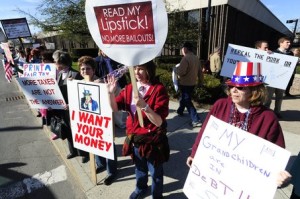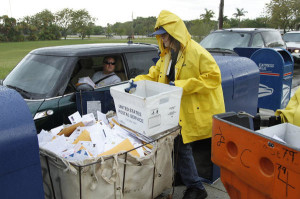 Steve Sipress
Head Rhino & Chief Strategist
Steve Sipress
Head Rhino & Chief Strategist
Effective Word Of Mouth Tactics – Part II

Yesterday was “Tax Day” here in the United States – the deadline for all Americans to submit their Income Tax returns and payments for the previous year.
Most American workers overpay their income taxes all year long in the form of deductions from their paychecks, lending their money to the federal government at zero interest for up to 16 months. They are then brainwashed to “celebrate” their “tax refund” when the federal government finally decides to return their own money back to them every spring.
(*NOTE: Finding ways to encourage Americans to spend their “tax refunds” with your business is a very smart and profitable exercise – a subject I’ll cover in a future post.)
Many self-employed Americans, on the other hand, do not lend their money to the federal government interest-free, but instead actually owe tax payments every April 15th. Unlike American worker/slaves, it is therefore not to our advantage to file and pay our income taxes early; we prefer keeping our own money as long as possible and making our income tax payments as close to the deadline as possible (*although we’d actually prefer not having to pay any income tax at all, like many Big Corporations).
Speaking of which…
For years, I used to stage my own personal “income tax protest” by driving to the main U.S. Post Office branch in whatever city I happened to be living in at the time to mail my return and payment just a few minutes before the stroke of midnight on the day of the deadline. (*I know, I know – I’m an extremist!)
If you’ve never done this, by the way, I suggest you at least make the late-night trip to your own local U.S. Post Office branch some April 15th. You’re likely to experience quite a scene, complete with bullhorn-toting, sign-holding groups of income tax protestors, local media people reporting from the scene and long lines of cars handing their envelopes to happy-to-be-getting-overtime postal workers through the windows of their cars.

Back in the 80’s and 90’s, when I used to participate in the madness, the gatherings were all impromptu and unorganized. These days, there are hundreds of highly-orchestrated events taking place at the same time throughout the nation, spearheaded by the tax-protest-inspired “Tea Party” movement.
But there are still no paid advertisements for these protests – no commercials, no billboards, no Pay-Per-Click ads on Google telling people to gather at post offices all across the country on a certain day and time.
That’s right – the entire nationwide spectacle occurs every year like clockwork, purely by “Word Of Mouth” advertising (like I just did here on this blog, by encouraging you to go experience one of these gatherings on a future April 15th, and like I did two weeks ago, when I warned you never to even THINK about flying on Spirit Airlines).
Last week, I started this series on Word Of Mouth and shared proven strategies and tactics to make your customers’ purchasing experience shorter and easier (not to mention less-costly for you than traditional advertising).
I’m going to continue with that theme today, sharing a few more effective ways to mold Word Of Mouth to your advantage.
First of all, why is Word Of Mouth so effective?
Everyone needs an advisor to guide them to make a decision. Top performers hire experienced and skilled coaches and advisors for different aspects of their business and personal lives, but the vast majority of people rely on “informal” Word Of Mouth by asking the opinions of their friends, family, neighbors, co-workers and even complete strangers (thanks to online message boards, blogs, review sites and social media).
The bottom-line is that we rely on the expertise and opinions of others to help us make the right decisions for ourselves.
When you take the time to understand exactly how Word Of Mouth works, you’ll see all the great advantages it has to offer you. By making the decision-making process faster and easier for your potential customers, you can forget about having to use typical low-ball advertising or the sleazy used-car-salesman approach, and increase your profits with less cost and more ease than ever before.
Here are the facts…
Traditional advertising draws about one response for every thousand times an ad is seen – and most of those are simply requests for more information before the customer even considers purchasing. It is an ever-increasing uphill battle just to build enough trust to overcome the prospect’s skepticism.
However, when you get a referral or opinion from a friend, you are MUCH more likely to take their word for it and act. On average, customers make a purchase based on two out of every five recommendations their friends make. That’s a HUGE difference over “cold” advertising to strangers.
Okay. We all know how powerful Word Of Mouth can be. Now here’s a definition of it:
Word Of Mouth is a communication that happens between a customer and a potential customer, usually involving a relationship of some kind between these two people with an established level of trust (although Word Of Mouth is increasingly happening between strangers, thanks to modern technology such as “review” websites and social media. In that case, the “trust” is often based on the website itself, such as Amazon, eBay, Craigslist, etc.).
Compare this to paid advertising, where you are broadcasting a message to potential customers who have not yet established a trusted relationship with you.
In which case are people more likely to trust the advice they get? The answer is obvious.
Here are some of the reasons why information that is generated through Word Of Mouth works so well:
-
It is custom-tailored to the potential customer because of the relationship with the referrer, making it more personal, relevant and believable.
-
It is seen as “customer-driven” – in contrast to information paid for by an advertiser with an agenda.
-
It is self-generating and can take on a life of its own – especially thanks to today’s interactive, hyper-connected internet technology.
-
It can become part of the product’s description, such as “the new energy drink that everyone’s talking about.”
One key factor to keep in mind is that the source of the Word Of Mouth can be important. Information is most highly-trusted and effective when coming from someone who is seen as an expert, trusted authority or celebrity.
Finally, in order to maximize Word Of Mouth you need to understand these three factors, and take the right actions based on the answers:
-
Where is your Word Of Mouth coming from?
-
Which of your products and/or services are being affected by Word Of Mouth?
-
How is your Word Of Mouth traveling?
Once you know these things you can work out a plan on how to trigger more positive Word Of Mouth for you and your business.
This wraps up today’s lesson on Word Of Mouth. In next week’s post, I’m going to dive into what I call The Nine Levels Of Word Of Mouth, to help you avoid negative Word Of Mouth and produce more of the positive, profit-producing kind.
*WARNING: You may have to pay more income taxes next year as a result of implementing these strategies.

Recent Comments